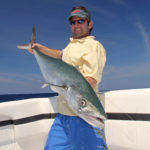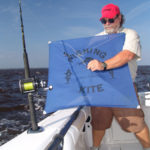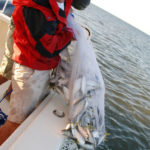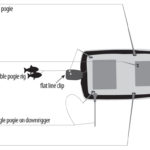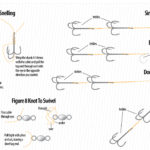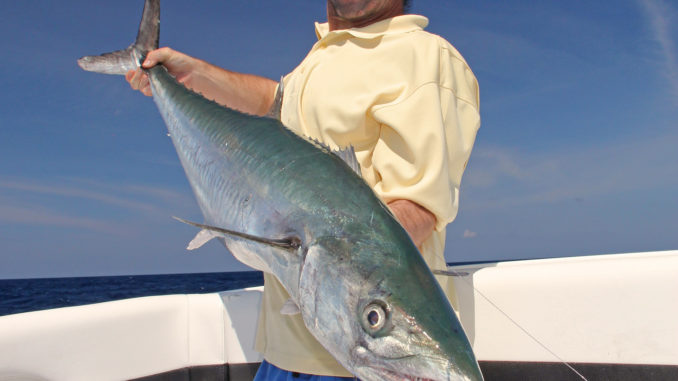
Size doesn’t matter when it comes to the boat in which you fish for king mackerel; it’s paying attention to details and all the little things.
Fall on North Carolina’s southern means two things. First, the crowds have left the beaches, and it is time for the best fishing of the year. Secondly, and perhaps more exciting, it is time for the some of the best king mackerel fishing of the year.
Tournament organizers know this, and virtually every weekend affords the opportunity for anglers to compete in either club tournaments, Southern Kingfish Association events, or the venerable U.S. Open. The stakes and pressure are high as fishermen from all over the region bring their boats, all hoping for a share of the glory and the riches that these contests provide an opportunity for.
At first glance, these tournaments are dominated by teams with giant twin- and triple-engine center consoles. Teams show up at weigh-ins in matching sponsor shirts weighing fish caught from 30-foot-plus Contenders, Fountains, or Yellowfins. But a closer look reveals that just as much money — and certainly as much glory — is taken by teams that fish smaller, less-ostentatious boats, often with a single outboard providing power. These are boats owned by the everyday fisherman, and they are proof positive that success on the king mackerel scene has less to do with equipment than it does the fisherman.
Jeff Beck of Ocean Isle is a shining of example of the success that fishermen in smaller boats can have catching king mackerel. His “Do Work” team is a family affair, with wife Courtney, father Ricky, daughter Camdyn, plus Timmy Clemmons and Jon Hayes. Together, they won an SKA division in 2010, fishing from a 24-foot Sea Hunt Triton.
Beck admits that there are some disadvantages to fishing a smaller boat but said they can be overcome with teamwork and preparation. Knowing he can’t run as far or fast as a bigger boat, or in rough seas, Beck puts extra time into figuring out where the fish will be within a reasonable distance from his starting spot. Not only that, but he has multiple contingency plans in case weather conditions change abruptly. For example, just before the 2010 Jolly Mon King Classic, fishing southwest of Shallotte had been the most productive, and most fishermen thought the winning fish would come from a couple of popular spots: the Jungle or the 410/510. The night before the tournament, he wind switched to southwest, and Beck knew running in that direction would beat up bait and crew. Instead, he chose to fish out the Cape Fear River channel, which meant a shorter run, more fishing time and healthier bait, all of which played a part in the 33.10-pound fish they caught close to nearby Lighthouse Rocks that won the tournament.
Preparation isn’t just limited to knowing where to fish. Beck said that space for tackle and rod storage can be a big issue not handled correctly. He makes sure that all rigs are tied, individually bagged and labeled before leaving the dock so there is no need to carry extra wire, swivels and boxes of hooks. Beck uses stranded wire and VMC trebles for all the team’s rigs, snelling the hooks to the wire and using Figure 8 knots to secure the swivel. The ease of making these rigs when compared to singlestrand, hard-wire means he can have more than a hundred ready to go in case they encounter a hot bite of smaller kings or have to work their way through sharks, amberjacks or other non-target species. Beck uses the “one rig, one fish” approach and doesn’t attempt to recycle rigs after a fish has been fought on one.
“The investment in the rig can be counted in pennies. It’s simply not worth it to try to re-use one on a fish that may be worth thousands of dollars,” said Beck, who uses different sizes of treble hooks depending on the bait he’s fishing. He’ll go with a No. 6 hook if he’s fishing small baits such as live cigar minnows or small menhaden, and up to Nos. 4 and 2 trebles with larger menhaden or bluefish. Some baits will be skirted, but Beck prefers naked baits, because he said that’s what the fish are used to seeing and eating. Rarely if ever will Beck even put a ribbonfish in the water, so he don’t even tie ribbonfish rigs anymore. It is a bait that just hasn’t ever given the team the results they want.
To fight a big king, Beck uses Shimano Speedmaster TSM4s or Avet 6:1 lever-drag reels on 7-foot Star Deluxe live-bait rods. The high-speed reels can hold nearly 450 yards of 20-pound which is checked frequently and changed when needed. Between the mono and the swivel, he team splices in 25 feet of disappearing pink fluorocarbon that serves as a shock absorber. The fluorocarbon allows Beck to fish shorter wire leaders, as a tail whip from a large king will often cut mono — but not fluorocarbon. Drags are set extremely light so as not to pull hooks if a king is foul-hooked or lightly hooked with the razor sharp trebles.
Beck said that there are a few other essential items for success from a small boat on large king mackerel. He carries a single downrigger rather than the twin setup found on larger boats. He will vary his depths with the downrigger based on what he is seeing on his depthfinder to try and find the depth in which the kings are feeding. He uses a two-piece gaff with a two-inch hook. The section with the hook is eight feet long, which is long enough for most situations. However, when they have to gamble, there is a four-foot section that screws on, allowing for a reach of over 12 feet, depending on the height and arm length of the gaff man.
To further maximize space with a live-bait spread deployed, Beck uses a flat-line clip on a suction cup, which is stuck to the motor cowl. This keeps the short-line bait down and out of the way, compensating for the smaller cockpit size. Finally, Beck will not leave the dock without an OIFC custom No. 22 cast net on board. This heavier net is perfect for catching spooky fall baits or sinking quickly on top of menhaden in the deeper water off of New Hanover County beaches.
Chris Dawson is another king mackerel fanatic who has enjoyed his share of success on his 21-foot Sea Hunt, the Miss Janelle. He fishes for kings every chance he gets, be it in a tournament, on a charter or just for fun with his wife Janelle and daughter Cassie. While he is willing to run offshore on a nice day, Dawson said most of his success comes close to the beach. It’s all about taking the right approach and knowing what to look for.
Of all the equipment on Miss Janelle, Dawson is most passionate about his depth sounder, a Furuno FCV-585 with an Airmar 1 kw tilted-element transducer. Most boats in this size class come with smaller sounders and less-powerful transducers, but being able to read and tune in the bait marks is a big deal to Dawson, so the upgrade is well worth the extra investment. He said there is little variation when it comes to chart plotters, but there is all the difference in the world when it comes to bottom machines. He fine-tunes the gains on his Furuno multiple times throughout the day when he is on his spot just to be sure he is seeing the whole picture down there. Finding and staying with the bait is paramount to this team’s success.
Dawson is also a big believer that line choice makes a difference when it comes to king fishing. He packs his Speedmasters full of Hi-Seas Quattro Camo line, in 20-pound test. This line choice accomplishes two things, he said. First of all, the camo line has a very small diameter, meaning he can pack nearly 500 yards on his reels, which comes in handy when fighting multiple fish or when a smoker makes his huge first run. Second of all, the camo line has a break-up pattern where the line continually changes color. An avid hunter, Dawson applies the same concepts of chasing whitetail deer to his king mackerel fishing. He said his catch rate skyrocketed when he made the switch to the camo line, and he has never looked back. He uses a blood knot to tie on a shot of Seaguar 30-pound fluorocarbon and knots his shock leader to the swivel on his rig, also tied with cable and VMC treble hooks.
Another trick that Dawson employs is a kite. He said a kite works better closer to the beach than offshore, making it perfect for the crew of a smaller boat to diversify its spread and catch a wary smoker. He carries both an AFTCO and SFE kite and changes them out based on wind speed. His kite rod setup has three release clips spaced out on 100-pound Power Pro braid, and he said has had success not only drifting with the kite, but trolling with it as well.
Dawson favors bigger baits, such as bluefish or “turbo” pogies for his kite, upsizes his hooks and fishes more drag on his reels. If the kite is not producing immediately, he keeps moving the baits further and further away from the boat, According to Dawson, the best part of fishing the kite is the bite; it is obvious and explosive!
DESTINATION INFORMATION
WHERE TO GO/HOW TO GET THERE — Wrightsville Beach, Carolina Beach, Southport and Ocean Isle are great jumping-off points for fall king mackerel fishing in small boats. Wrightsville Beach and Carolina Beach are easily accessed by taking I-40, US 17 or US 421 to Wilmington. To Wrightsville Beach, head east on US 76; a public boat landing is on the left as you come onto the island. From Wilmington to Carolina Beach, take US 421 (Carolina Beach Rd.) and head south. A newly renovated ramp is just past the bridge over Snow’s Cut. Southport is across the Cape Fear River from Wilmington to the southwest, most easily accessed from US 17 and NC 211. The most-popular public ramp is on Fish Factory Rd. To reach Ocean Isle, take NC 130 off US 17 in Shallotte and head south. A public ramp is at the base of the bridge on the island side.
FISHING INFO/GUIDES — Tex’s Tackle, Wilmington, 910-791-1763; Island Tackle and Hardware, Carolina Beach, 910-458-3049; The Tackle Box/Southport Marina, 866 395-3474; Ocean Isle Fishing Center, 910-575 3474. See also Guides and Charters in Classifieds.
ACCOMMODATIONS — The Blockade Runner, Wrightsville Beach, 910 256-2251; Sea Witch Motel, Carolina Beach, 910-707-0058; Drifter’s Reef Motel, Carolina Beach, 910-458-5414; Comfort Suites, Southport, 888-946-6483; Hampton Inn, Southport, 800-992 2694; Islander Inn, Ocean Isle, 888-325 4753; Ocean Isle Inn, Ocean Isle, 910-579 0750.
MAPS — ProFinder Charts, 910-512 6700, www.prochipusa.com; Capt. Segull’s Nautical Charts, 888-473-4855, www.captainsegullcharts.com; Sealake Fishing; Guides, 800-411-0185, www.thegoodspots.com; Maps Unique, 910-458-9923, www.mapsunique.com. GMCO’s Chartbook of North Carolina, 888-420-6277, www.gmcomaps.com.

